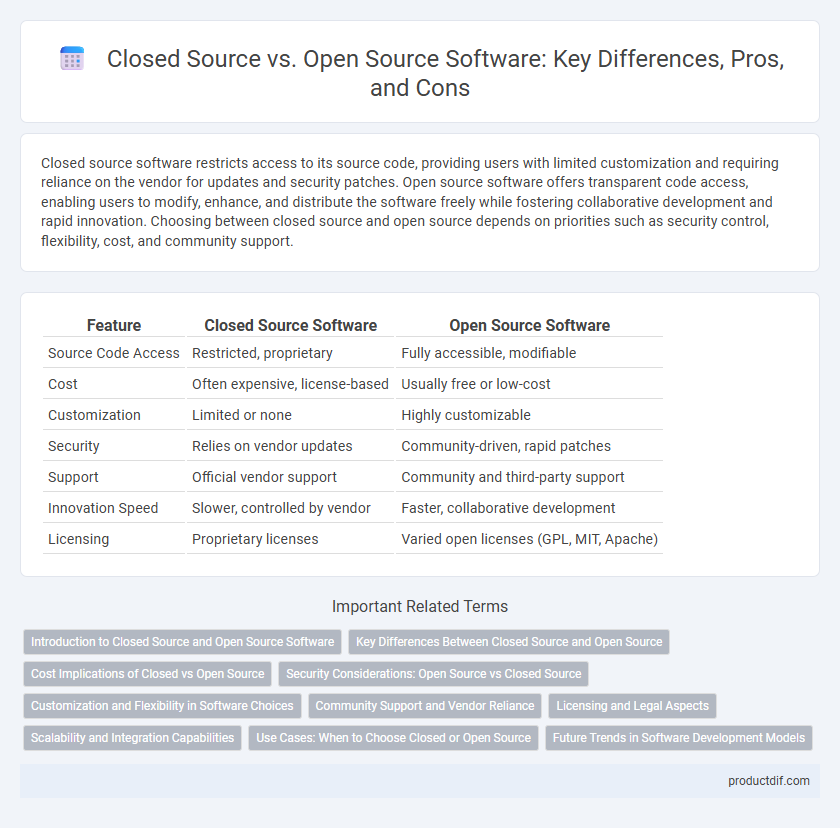Closed source software restricts access to its source code, providing users with limited customization and requiring reliance on the vendor for updates and security patches. Open source software offers transparent code access, enabling users to modify, enhance, and distribute the software freely while fostering collaborative development and rapid innovation. Choosing between closed source and open source depends on priorities such as security control, flexibility, cost, and community support.
Table of Comparison
| Feature | Closed Source Software | Open Source Software |
|---|---|---|
| Source Code Access | Restricted, proprietary | Fully accessible, modifiable |
| Cost | Often expensive, license-based | Usually free or low-cost |
| Customization | Limited or none | Highly customizable |
| Security | Relies on vendor updates | Community-driven, rapid patches |
| Support | Official vendor support | Community and third-party support |
| Innovation Speed | Slower, controlled by vendor | Faster, collaborative development |
| Licensing | Proprietary licenses | Varied open licenses (GPL, MIT, Apache) |
Introduction to Closed Source and Open Source Software
Closed source software refers to proprietary programs whose source code is restricted and not publicly accessible, ensuring control by the developer or company. Open source software offers freely available source code, enabling users to modify, enhance, and distribute the software under licenses like GPL or MIT. The primary distinction lies in accessibility and collaboration, impacting security, customization, and development innovation within the software industry.
Key Differences Between Closed Source and Open Source
Closed source software restricts access to its source code, limiting modifications and distribution, while open source software offers full transparency and freedom to modify, enhance, and redistribute the code. Licensing models differ significantly, with closed source typically governed by proprietary licenses and open source by licenses such as GPL, MIT, or Apache, promoting collaboration. Security, cost, and community involvement also vary; open source benefits from community scrutiny and customization, whereas closed source relies on vendor assurances and often entails licensing fees.
Cost Implications of Closed vs Open Source
Closed source software often involves higher upfront costs due to licensing fees and subscription models, impacting budget allocation for businesses. Open source software reduces expenses by offering free or low-cost access, but may require investment in customization, maintenance, and support services. Total cost of ownership varies depending on the organization's technical expertise and specific software requirements.
Security Considerations: Open Source vs Closed Source
Open source software allows for transparent code review by a global community, enhancing vulnerability identification and patching speed, which strengthens security posture. Closed source software relies on proprietary development, limiting external scrutiny and potentially delaying the discovery and resolution of security flaws. Security effectiveness depends on factors such as the development process maturity, frequency of updates, and the responsiveness of the maintainers, regardless of the software being open or closed source.
Customization and Flexibility in Software Choices
Closed source software limits customization options because the source code is not accessible, restricting users to predefined features and vendor updates. Open source software provides high flexibility by allowing users to modify, enhance, and tailor the code to specific needs, fostering innovation and adaptability. This distinction significantly impacts software choices, especially for businesses requiring bespoke solutions or rapid iteration.
Community Support and Vendor Reliance
Closed source software typically relies heavily on vendor support for updates, troubleshooting, and feature improvements, limiting community involvement and often resulting in slower innovation cycles. Open source software benefits from active community contributions, enabling rapid bug fixes, extensive customization, and continuous enhancements driven by diverse developers worldwide. Robust community support in open source projects often reduces vendor reliance, fostering greater transparency and flexibility for users and organizations.
Licensing and Legal Aspects
Closed source software restricts access to source code, enforcing proprietary licensing agreements that limit usage, modification, and distribution, often accompanied by strict legal protections and penalties for violations. Open source software operates under licenses such as GPL, MIT, or Apache, which grant users rights to freely use, modify, and distribute the software while imposing conditions like copyleft or attribution to maintain legal compliance. Understanding these licensing frameworks is crucial for developers and organizations to navigate intellectual property rights, compliance requirements, and potential liabilities in software deployment and development.
Scalability and Integration Capabilities
Closed source software often provides robust scalability through controlled environments and dedicated vendor support, enabling seamless integration with proprietary systems. Open source solutions offer flexible scalability driven by community-driven enhancements and customizable code, facilitating diverse integration possibilities across various platforms. Both models present unique advantages depending on specific scalability demands and integration ecosystem requirements.
Use Cases: When to Choose Closed or Open Source
Closed source software is ideal for businesses requiring proprietary solutions with dedicated support, enhanced security, and strict intellectual property control, often seen in industries like finance and healthcare. Open source software suits organizations prioritizing customization, cost-effectiveness, and collaborative development, commonly used in startups, educational institutions, and research. Evaluating factors such as budget, security requirements, scalability needs, and community support helps determine the best choice between closed and open source software.
Future Trends in Software Development Models
Future trends in software development models emphasize hybrid approaches combining the security of closed source with the flexibility of open source. Increased adoption of open source components accelerates innovation and collaboration while proprietary tools maintain competitive advantages through exclusive features. Emerging technologies like artificial intelligence and blockchain drive shifts toward more transparent, community-driven development ecosystems alongside traditional proprietary frameworks.
Closed Source vs Open Source Infographic

 productdif.com
productdif.com